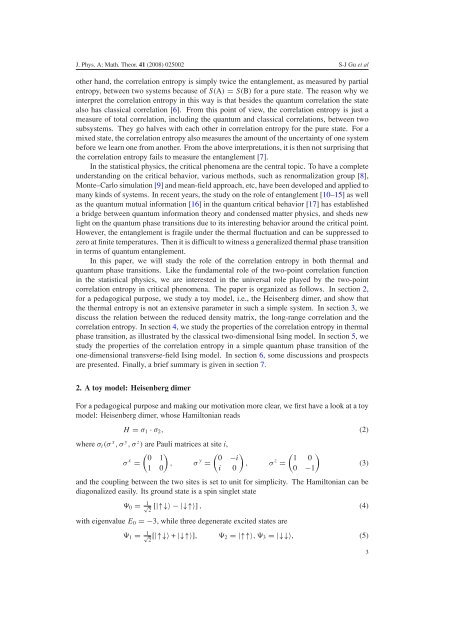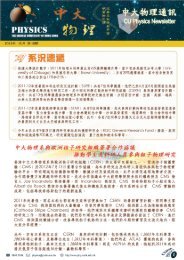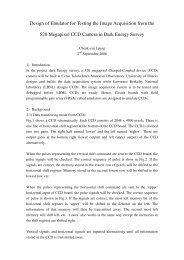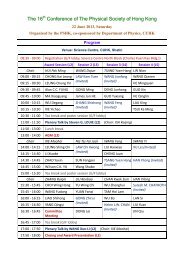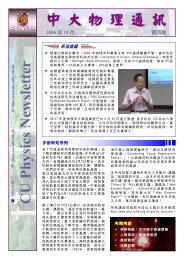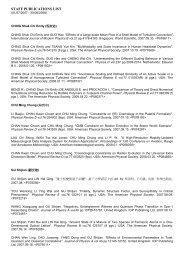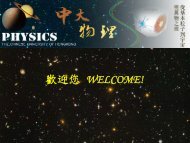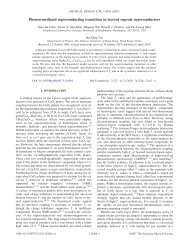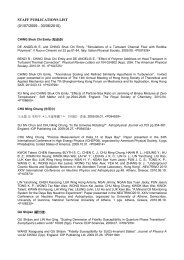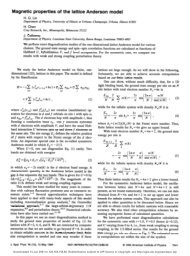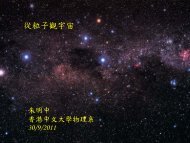Universal role of correlation entropy in critical phenomena
Universal role of correlation entropy in critical phenomena
Universal role of correlation entropy in critical phenomena
You also want an ePaper? Increase the reach of your titles
YUMPU automatically turns print PDFs into web optimized ePapers that Google loves.
J. Phys. A: Math. Theor. 41 (2008) 025002 S-J Gu et al<br />
other hand, the <strong>correlation</strong> <strong>entropy</strong> is simply twice the entanglement, as measured by partial<br />
<strong>entropy</strong>, between two systems because <strong>of</strong> S(A) = S(B) for a pure state. The reason why we<br />
<strong>in</strong>terpret the <strong>correlation</strong> <strong>entropy</strong> <strong>in</strong> this way is that besides the quantum <strong>correlation</strong> the state<br />
also has classical <strong>correlation</strong> [6]. From this po<strong>in</strong>t <strong>of</strong> view, the <strong>correlation</strong> <strong>entropy</strong> is just a<br />
measure <strong>of</strong> total <strong>correlation</strong>, <strong>in</strong>clud<strong>in</strong>g the quantum and classical <strong>correlation</strong>s, between two<br />
subsystems. They go halves with each other <strong>in</strong> <strong>correlation</strong> <strong>entropy</strong> for the pure state. For a<br />
mixed state, the <strong>correlation</strong> <strong>entropy</strong> also measures the amount <strong>of</strong> the uncerta<strong>in</strong>ty <strong>of</strong> one system<br />
before we learn one from another. From the above <strong>in</strong>terpretations, it is then not surpris<strong>in</strong>g that<br />
the <strong>correlation</strong> <strong>entropy</strong> fails to measure the entanglement [7].<br />
In the statistical physics, the <strong>critical</strong> <strong>phenomena</strong> are the central topic. To have a complete<br />
understand<strong>in</strong>g on the <strong>critical</strong> behavior, various methods, such as renormalization group [8],<br />
Monte–Carlo simulation [9] and mean-field approach, etc, have been developed and applied to<br />
many k<strong>in</strong>ds <strong>of</strong> systems. In recent years, the study on the <strong>role</strong> <strong>of</strong> entanglement [10–15]aswell<br />
as the quantum mutual <strong>in</strong>formation [16] <strong>in</strong> the quantum <strong>critical</strong> behavior [17] has established<br />
a bridge between quantum <strong>in</strong>formation theory and condensed matter physics, and sheds new<br />
light on the quantum phase transitions due to its <strong>in</strong>terest<strong>in</strong>g behavior around the <strong>critical</strong> po<strong>in</strong>t.<br />
However, the entanglement is fragile under the thermal fluctuation and can be suppressed to<br />
zero at f<strong>in</strong>ite temperatures. Then it is difficult to witness a generalized thermal phase transition<br />
<strong>in</strong> terms <strong>of</strong> quantum entanglement.<br />
In this paper, we will study the <strong>role</strong> <strong>of</strong> the <strong>correlation</strong> <strong>entropy</strong> <strong>in</strong> both thermal and<br />
quantum phase transitions. Like the fundamental <strong>role</strong> <strong>of</strong> the two-po<strong>in</strong>t <strong>correlation</strong> function<br />
<strong>in</strong> the statistical physics, we are <strong>in</strong>terested <strong>in</strong> the universal <strong>role</strong> played by the two-po<strong>in</strong>t<br />
<strong>correlation</strong> <strong>entropy</strong> <strong>in</strong> <strong>critical</strong> <strong>phenomena</strong>. The paper is organized as follows. In section 2,<br />
for a pedagogical purpose, we study a toy model, i.e., the Heisenberg dimer, and show that<br />
the thermal <strong>entropy</strong> is not an extensive parameter <strong>in</strong> such a simple system. In section 3, we<br />
discuss the relation between the reduced density matrix, the long-range <strong>correlation</strong> and the<br />
<strong>correlation</strong> <strong>entropy</strong>. In section 4, we study the properties <strong>of</strong> the <strong>correlation</strong> <strong>entropy</strong> <strong>in</strong> thermal<br />
phase transition, as illustrated by the classical two-dimensional Is<strong>in</strong>g model. In section 5, we<br />
study the properties <strong>of</strong> the <strong>correlation</strong> <strong>entropy</strong> <strong>in</strong> a simple quantum phase transition <strong>of</strong> the<br />
one-dimensional transverse-field Is<strong>in</strong>g model. In section 6, some discussions and prospects<br />
are presented. F<strong>in</strong>ally, a brief summary is given <strong>in</strong> section 7.<br />
2. A toy model: Heisenberg dimer<br />
For a pedagogical purpose and mak<strong>in</strong>g our motivation more clear, we first have a look at a toy<br />
model: Heisenberg dimer, whose Hamiltonian reads<br />
H = σ 1 · σ 2 , (2)<br />
where σ i (σ x ,σ y ,σ z ) are Pauli matrices at site i,<br />
( ) 0 1<br />
σ x = , σ y =<br />
1 0<br />
( 0 −i<br />
i 0<br />
)<br />
( ) 1 0<br />
, σ z =<br />
0 −1<br />
and the coupl<strong>in</strong>g between the two sites is set to unit for simplicity. The Hamiltonian can be<br />
diagonalized easily. Its ground state is a sp<strong>in</strong> s<strong>in</strong>glet state<br />
0 = 1 √<br />
2<br />
[|↑↓〉 − |↓↑〉] , (4)<br />
with eigenvalue E 0 =−3, while three degenerate excited states are<br />
1 = 1 √<br />
2<br />
[|↑↓〉 + |↓↑〉], 2 = |↑↑〉, 3 =|↓↓〉, (5)<br />
(3)<br />
3


